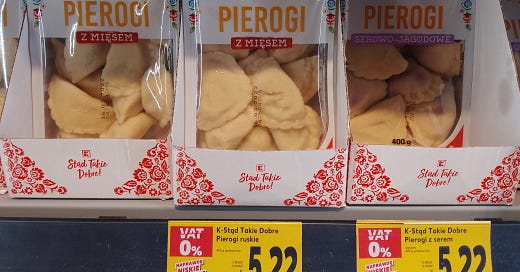Sometimes, you can directly translate a phrase into another language and it makes perfect sense. “Święty Jacek z pierogami!” is not one of those phrases.
Literally translated, it means “St. Hyacinth and his pierogi!” but is used in the same way as “Holy cow!” Legend has it that the medieval Saint Hyacinth invented pierogi (filled dumplings) during a famine and miraculously multiplied them to feed the masses.
However they came to be, pierogi remain a popular Polish dish, and come in a wide variety of savory and sweet types:
pierogi ruskie (potato, cheese, and a little onion)
pierogi z kapustą i grzybami (cabbage, mushrooms, and a little carrot)
pierogi z mięsem (shredded pork)
pierogi z serem i szpinakiem (cottage cheese and spinach)
pierogi z serem (cottage cheese)
pierogi z serowo-jagodowe (cottage cheese and blueberries)
pierogi z truskawkami (strawberry preserves)
Pierogi ruskie and pierogi z mięsem are probably the two most common types. There are other types of pierogi, but to list them all here would be like listing every possible pizza topping. They are found in Polish restaurants, but can also be found premade in grocery stores, which carry a wider range of types. These refrigerated pierogi cost 5.22 PLN (about 1.25 USD) for 400 grams (about 14 ounces).
Pierogi can also be found at some grocery stores in the US, with “cheese pierogi” being pierogi ruskie, and the “Great Pierogy Race” is held at every Pittsburgh Pirates baseball game at PNC Park, where people in pierogi costumes race each other between innings.
New Articles:
It’s not an article per se, but if you’re curious about my hometown, check out a March 3rd Facebook post I authored for my school here:
https://www.facebook.com/myspeedGliwice
Read more of my writing at:
https://muckrack.com/adam-larson-2/portfolio



